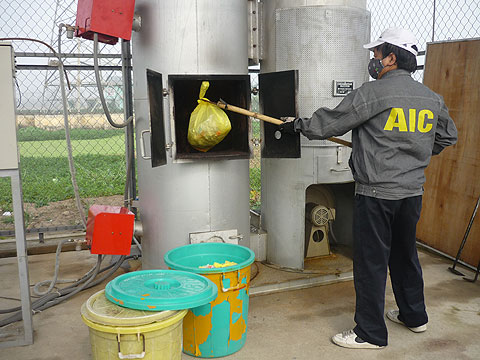Clean medical waste by Japanese technology
Medical solid wastes such as bandages, gauze, needles, specimens . are very difficult to disintegrate and often cause pollution, affecting the environment of people living near areas with hospitals. However, with the method of using medical solid waste incinerators, this situation has been resolved completely.
In the past, these wastes were only treated by conventional landfill method, so far, more than 20 provinces and cities nationwide have been installed by the International Advanced Joint Stock Company (AIC). put and put into use incinerator according to waste treatment technology of Japan. Chuwa medical solid waste incinerator technology with Model F-1S has the standard of meeting TCVN 7380-2004 on medical solid waste incinerator.
Thorough handling of Dioxin
Structure of incinerator consists of two primary and secondary combustion chambers. The primary combustion chamber is designed on the principle of forced blowing, forming a vortex of air in the furnace, so it always maintains a large amount of oxygen and prevents black smoke.
Secondary combustion chamber fitted with combustion equipment helps maintain temperature above 8.00 degrees C to ensure destruction of pathogens and enough decomposition of Dioxin.
The combustion chamber is divided into three layers, the outer layer is the insulation. Wrapped around is a layer of water that reduces the heat of the combustion chamber, making the combustion chamber longer.

Operating waste incinerators at Nam Dinh Province's Tuberculosis and Lung Hospital.Photo: Quynh Anh
Surrounding the combustion area is designed to have a multitude of small holes to provide air, thanks to the effect of the air that the first burning waste will be burned the second time.
The floor of the furnace has a gas-conducting system designed to avoid the incineration, improving the minimum capacity, complete ashing. In the process of burning without an island, fly ash is restricted.
The incinerator is fitted with an auxiliary system, maintaining low pressure at the entrance of the garbage, avoiding the fire and smoke bouncing. Fuel used as fuel is crude oil, on average need 0.2kg of oil / kg of garbage. The capacity of the kiln reaching 25-30kg / hour can operate continuously for 15 hours / day.
Suitable for district hospitals
Mr. Nguyen Huu Hanh, Director of Dong Hung District General Hospital, Thai Binh Province, one of the units has been installed a medical solid waste incinerator system, said: When there is no incinerator, medical waste In the hospital, it is destroyed by manual method of burying or impregnating oil to burn. This method takes a lot of labor and especially causes environmental pollution, the risk of spreading infectious diseases is very high. 'But since the installation, the F-1S waste treatment furnace has met the demand for waste treatment on the day of the hospital,' Hanh said.
Ms. Pham Thi Ly, Head of the Anti-Infection Division of Dong Hung General Hospital, shared: 'Since being installed an incinerator, the treatment of medical waste at the hospital has been greatly shortened and saved. With the workers, the smoke emitted by the system does not see outdoor gas color, does not cause environmental pollution '.
According to the assessment, the application of the most advanced medical solid waste incinerator system in Japan has solved the medical waste source which is dangerous to human health.
Chuwa brand furnace is also rated as suitable for district hospitals. Currently the international progress company AIC is responsible for installing and transferring this medical waste incinerator technology at a cost of about VND 700 million / furnace.
- Use leaves for scrub to clean medical waste
- Master plan of medical solid waste treatment system
- 'Engineers are not equal to processing medical waste treatment furnaces
- Waste treatment solution for hospitals in Vietnam
- New technology to treat industrial wastewater into clean water
- Clean water and numbers to speak
- Big break: Recyclable plastic waste will be turned into super clean electricity
- America develops technology to separate water from animal waste
- Piloting Japanese-style waste burial model in Hanoi
- Only 3 days to 'fly' the smell of To Lich river: What is Japanese technology placed on the bottom of the river?
- Clean technology is lacking capital
- Generators from waste water
 Is the magnetic North Pole shift dangerous to humanity?
Is the magnetic North Pole shift dangerous to humanity? Washington legalizes the recycling of human bodies into fertilizer
Washington legalizes the recycling of human bodies into fertilizer Lightning stone - the mysterious guest
Lightning stone - the mysterious guest Stunned by the mysterious sunset, strange appearance
Stunned by the mysterious sunset, strange appearance